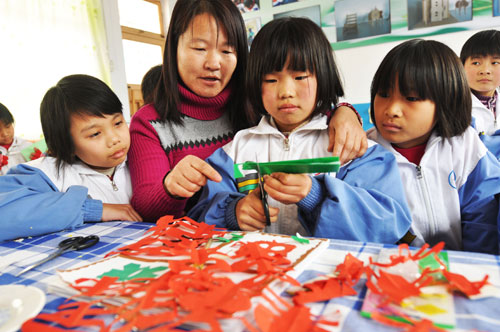|
 |
|
PAPER-CUTS: Zhu Xiaodong (second left), a folk artist, teaches students to do paper-cutting at Taizizhen Center Primary School of Zouping County, east China's Shandong Province (DONG NAIDE) |
"I like playing the violin, and I can already play several songs," said Wei Luxi happily, holding a violin. She lives in Fengtai District in Beijing, and her parents are both well-paid engineers. At five years old, the kindergartner has played the violin for a year and is already doing well with the musical instrument.
Wei's story is not unusual. In addition to classes at kindergarten, most of her classmates attend weekend art classes, learning piano, violin, painting, ballet and other skills.
However, children in rural areas are missing out on the education enjoyed by kids like Wei in urban neighborhoods. Insufficient teaching staff and poor facilities mean many rural primary schools lack the resources to offer students art education. Music, fine art, dance, theater, film, and other creative studies are out of reach for many children outside of China's urban centers.
"Art education is still missing in many rural primary schools, especially those in remote areas," said Liu Xiya, headmaster of Xiejiawan Primary School in southwest China's Chongqing Municipality.
Liu has taught music and fine art for about 10 years. In order to get first-hand information about the art learning situation of rural students, she conducted questionnaire surveys. To her delight, the surveys showed the children had very extensive interests, with some wishing to make a difference in the art field. However, some had never taken a class in the arts.
Although authorities have recognized the positive benefits of art schooling in rural areas, the conditions remain quite poor, said Liu.
Liu's belief was shared by Zhang Xingyi, a fine art teacher of Chuxiong Experimental Primary School in southwest China's Yunnan Province.
The lack of resources like musical instruments made it difficult to form a sound art education atmosphere, said Zhang.
"The fine art classes are often occupied by the so-called major subjects such as the Chinese language and mathematics, due to the examination pressure," Zhang continued. "My students seldom have opportunities to learn fine art."
Liu and Zhang speak for nearly all rural art teachers. Educators hope more children in small towns and villages will have the opportunity to access art, create artwork and devote more time to art education.
The lack of professional art teachers ranks first among all the challenges facing rural art education programs.
"Our township has two schools and three teaching centers. However, for these five places, there is only one fine art teacher and one music teacher. Due to the lack of teachers, some schools could only put a television in the classroom, and let the students learn singing from the TV," said Zhang Guijie, headmaster of a center school in Wenchen, Chiping County of east China's Shandong Province.
Many schools require teachers of other subjects to lead art classes as well. As a result, the teaching quality can be poor.
According to recent statistics by Ministry of Education, urban schools are suffering from a 29-percent and 12.2-percent shortfall in music and fine art teachers respectively, while rural schools face an incredible 60.4-percent and 58.6-percent shortage.
The big difference in art education between urban and rural areas stems from the policy on the number of teachers. The current policy is decided by a rule made in 2001 which sets the pupil-teacher ratio in cities at 18:1, and 23:1 in rural areas, said Yuan Guilin, a professor of education at Beijing Normal University.
Based on this standard, the number of teachers is determined by the number of students. Where there are more students, particularly in urban areas, there are more teachers. The policy has contributed to the incomplete education of rural primary school students, said Yuan.
The shortage of available funds is another big challenge, and is most severe in rural places.
The limited funds are mostly spent on necessary teaching materials. Whatever money is left over is often invested in major subjects like math and Chinese language study instead of the arts. For a long time, the equipment required for art education has not been properly maintained, said Lu Shide, Director of the Education Bureau of Fusong County, northeast China's Jilin Province.
| 